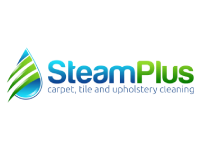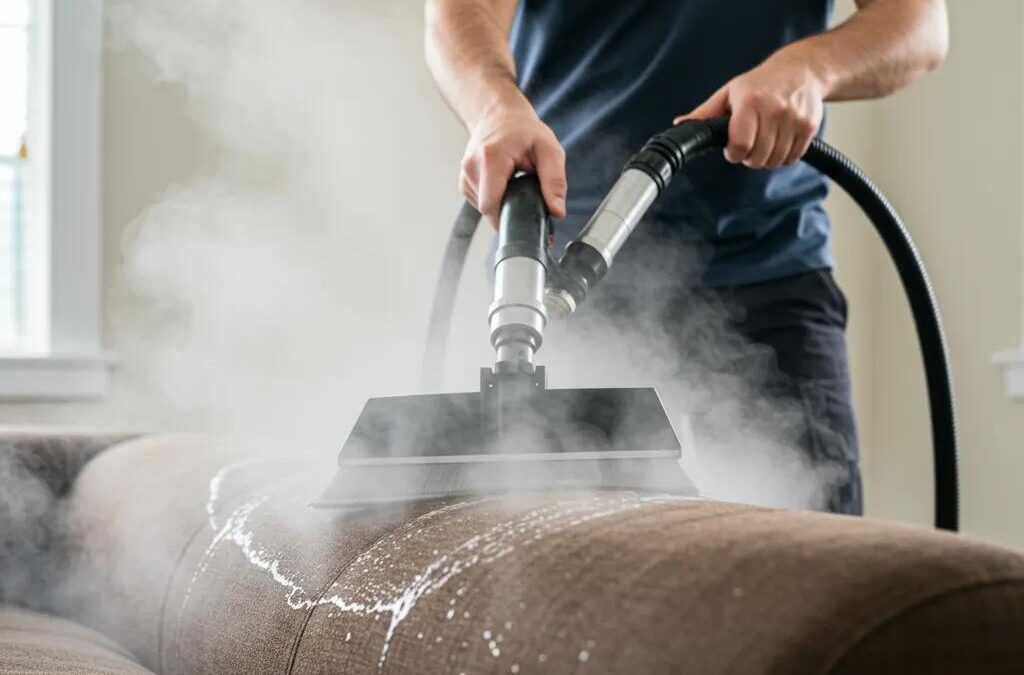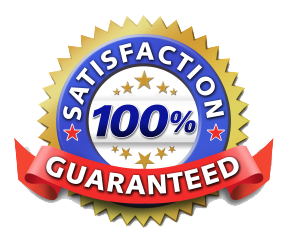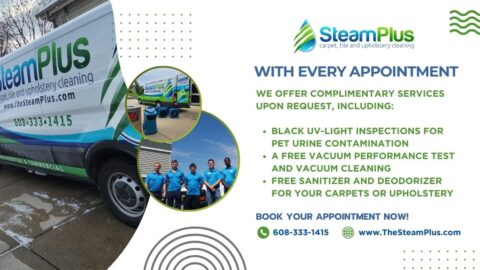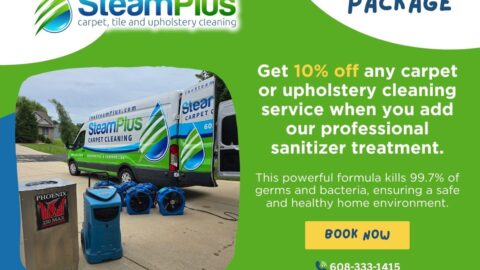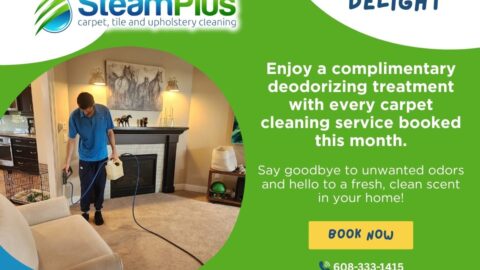Commercial upholstery cleaning services demand precision, speed, and deep sanitation to maintain furniture in bustling environments. Steam Plus Carpet Cleaning and Water Restoration’s team combines advanced methods—hot water extraction, dry solvent processes, foam encapsulation, and leather-specific treatments—to remove soils, kill pathogens, and accelerate drying for minimal downtime. Readers will discover how each technique works, when to choose it based on fabric type and soil level, the full four-step professional cleaning process, and the tangible benefits of routine maintenance. This guide maps out core methods, fabric-specific requirements, decision factors, procedural phases, performance advantages, common customer questions, and the role of modern equipment and eco-friendly solutions in achieving pristine, long-lasting upholstery.
What Are the Most Effective Commercial Upholstery Cleaning Techniques?
Commercial upholstery cleaning excellence stems from matching method, equipment, and chemistry to fabric and soil conditions. Techniques deliver deep-clean extraction or low-moisture solvent action that lifts dirt without harming fibers. For challenging commercial environments, professionals select from four principal approaches—steam cleaning for thorough sanitization, dry cleaning for moisture-sensitive textiles, foam encapsulation for rapid turnaround, and specialized leather care for premium finishes—and tailor preparations and aftercare accordingly.
How Does Hot Water Extraction (Steam Cleaning) Work for Commercial Upholstery?
Hot water extraction injects pressurized hot water mixed with a cleaning solution into upholstery fibers, then immediately vacuums the emulsified soil and contaminants for deep sanitization and accelerated drying.
- Technicians inspect fabric to confirm heat tolerance and identify stains.
- A pre-spray solution breaks down oils, grease, and embedded debris.
- High-pressure hot water is applied and immediately extracted by a commercial-grade wand.
- Residual moisture is minimized through powerful suction and optional heated air circulation.
This method enhances indoor air quality by removing allergens and bacteria while restoring fabric appearance, setting the stage for targeted dry approaches on moisture-sensitive materials.
What Are the Benefits and Uses of Dry Cleaning Methods in Commercial Settings?
Dry cleaning methods rely on solvent-based or encapsulation agents to dissolve oils and bind soils into dry particles, enabling fiber protection and minimal moisture exposure.
- Solvent-Based Cleaning uses non-water detergents that lift grease and oil without swelling fibers.
- Encapsulation Cleaning applies polymer-based detergents that crystallize around soils and are vacuumed away.
Benefits include rapid turnaround, reduced risk of mold or shrinkage, and suitability for delicate upholstery in hotels, theaters, and executive offices. These advantages naturally lead to foam encapsulation for even faster service cycles.
Encapsulation and Foam Cleaning for Particulate Soil Removal A novel wetting agent enables the cleaning formulation to loosen and encapsulate particulate soil. We offer a comprehensive range of specialized foam generation equipment designed to complement our proprietary foaming Traffic Film Removers (TFRs).Cleaning products.
How Is Foam Cleaning Applied to Commercial Upholstery?
Foam cleaning applies low-moisture detergent foam that encapsulates and lifts soil from upholstery fibers before extraction.
- A measured foaming agent is agitated into cushions and fabric surfaces.
- Micro-bubble foam penetrates deep pile and loosens dirt without oversaturation.
- A dry-vacuum wand removes foam and encapsulated particles, reducing drying time by up to 70%.
Foam cleaning enhances fabric protection and is ideal for large seating areas where quick reuse is essential, seamlessly bridging to leather care for premium finishes.
What Specialized Techniques Are Used for Leather Upholstery in Businesses?
Leather upholstery cleaning employs pH-balanced cleaners, gentle agitation tools, and conditioning agents to remove grime, restore natural oils, and preserve suppleness.
- A non-alkaline leather cleaner dissolves surface soils without stripping dyes.
- Soft-bristle brushes and microfiber cloths lift debris from grain and creases.
- Application of a color-restoring conditioner replenishes oils and seals pores.
- Optional protective coatings shield against future spills and UV fade.
These leather-specific practices ensure durability and appearance in lobbies, boardrooms, and hospitality suites, transitioning into fabric-type considerations for broader upholstery care.
Which Commercial Upholstery Fabrics Require Specific Cleaning Methods?
Commercial upholstery fabrics range from micro-synthetic solids to natural wool, each demanding tailored approaches to preserve texture and color. Selecting the correct cleaning method prevents fiber damage and supports manufacturer warranties.
| Fabric Type | Cleaning Requirement | Recommended Method |
|---|---|---|
| Microfiber (Polyester) | Low-abrasion, solvent-compatible | Hot Water Extraction or Dry |
| Wool Blend | Neutral pH, controlled moisture | Foam or Encapsulation Cleaning |
| Synthetic Blends | High durability, moisture tolerance | Steam Cleaning |
Microfiber responds to both steam and solvent processes, wool requires gentle detergents, and synthetic blends handle heat and pressure, guiding business managers to make informed method choices.
How Should Microfiber Upholstery Be Cleaned Professionally?
Microfiber upholstery benefits from hot water extraction or low-pH solvent cleaning that lifts embedded debris while preserving fiber integrity. Technicians pre-treat oily stains with solvent sprays, then employ steam or encapsulation to remove soils. Final grooming and quick-dry airflow restore nap and uniform appearance for conference chairs and lounge seating.
What Are the Best Practices for Cleaning Wool Upholstery in Commercial Spaces?
Wool upholstery demands gentle cleaning with neutral-pH detergents and controlled moisture levels to prevent shrinkage and fiber damage. Professionals test a discrete area, apply low-foaming agents, and use minimal water extraction. This process maintains wool’s natural lanolin content and boosts stain resistance, ensuring plush durability in upscale environments.
How Do You Clean Synthetic Fabric Upholstery in Offices and Commercial Areas?
Synthetic upholstery, such as polyester or nylon blends, responds well to steam cleaning and foam encapsulation that eliminate soils and enhance fabric resilience without residue. Pre-inspection confirms colorfastness, followed by high-pressure hot water or low-moisture foam to remove oils and dirt. Rapid drying maintains business continuity in high-traffic lobbies and waiting rooms.
How Do You Choose the Right Upholstery Cleaning Method for Your Business?
Selecting the right upholstery cleaning method hinges on fabric type, soil level, desired drying time, and environmental considerations. Balancing these factors improves cleaning efficiency, protects assets, and minimizes service interruptions.
- Fabric Type determines solvent compatibility and heat tolerance.
- Soil Level drives pre-treatment intensity and agent selection.
- Drying Time influences choice between low-moisture and wet-extraction approaches.
- Environmental Impact guides the use of eco-friendly solutions.
These decision points frame a deeper discussion of individual factors and green cleaning options.
What Factors Affect the Choice of Cleaning Method: Fabric Type, Soil Level, and Drying Time?
Selecting a cleaning method requires assessing each key factor to match performance with commercial needs.
| Factor | Impact | Recommendation |
|---|---|---|
| Fabric Type | Determines fiber tolerance and risk | Use dry methods for delicate fabrics, steam for robust textiles |
| Soil Level | Influences pre-treatment strength | Increase enzyme or solvent concentration for heavy soils |
| Drying Time | Affects business turnaround | Choose foam encapsulation or dry cleaning for fastest dry times |
Understanding these variables ensures optimal cleaning outcomes and supports brand reliability.
How Do Eco-Friendly and Green Cleaning Solutions Impact Commercial Upholstery Care?

Green cleaning solutions use biodegradable detergents and low-VOC solvents to improve indoor air quality, reduce chemical residues, and support sustainable business practices. Benefits include enhanced occupant health, reduced environmental footprint, and alignment with corporate sustainability goals. Integrating these solutions fosters trust and positions businesses as responsible stewards of public spaces.
What Is the Step-by-Step Process of Professional Commercial Upholstery Cleaning?
A professional commercial upholstery cleaning process follows structured phases—pre-inspection, pre-treatment, main application, and post-cleaning protection—to ensure thorough cleaning and extended furniture lifespan. Each phase builds on the last, reinforcing quality and minimizing risk.
Why Is Pre-Inspection and Fabric Testing Crucial Before Cleaning?
Pre-inspection and fabric testing identify material composition, stain types, and manufacturer guidelines, guiding method selection and preventing damage. Technicians note colorfastness, seam strength, and previous treatments, establishing a tailored cleaning plan that safeguards upholstery and maximizes cleaning efficiency.
How Are Pre-Treatment and Spot Removal Performed on Commercial Upholstery?
Pre-treatment applies targeted stain removers, enzyme agents, and pH-balanced sprays to break down specific soils before main cleaning. Technicians agitate spots with soft brushes, allowing dwell time for chemical action. This step enhances overall cleaning efficacy and reduces the risk of residual marks.
What Happens During the Main Cleaning Application?
During the main application, technicians apply the chosen cleaning agents—whether hot water extraction, dry solvents, or foam encapsulation—and operate specialized extractors or low-moisture machines. High-efficiency vacuums lift emulsified soils while minimizing moisture retention, delivering deep fiber penetration and effective soil removal.
How Is Post-Cleaning Protection Applied to Extend Upholstery Life?
Post-cleaning protection involves applying fabric guard or leather conditioner to repel future stains, boost fiber resilience, and promote longevity. Protective coatings fill pores and create hydrophobic barriers, reducing maintenance frequency and preserving a fresh appearance in commercial environments.
What Are the Key Benefits of Professional Commercial Upholstery Cleaning?
Professional commercial upholstery cleaning delivers measurable return on investment by extending furniture life, enhancing indoor air quality, and boosting brand image through pristine presentation. Businesses experience lower replacement costs, healthier interiors, and elevated customer perception when seating surfaces look and feel their best.
How Does Regular Cleaning Extend the Lifespan of Commercial Furniture?
Regular cleaning removes abrasive particles that degrade fibers, supports protective coatings, and delays replacement cycles to optimize asset value. Scheduled maintenance keeps upholstery surfaces smooth, prevents permanent staining, and maintains structural integrity, ensuring furniture remains functional for years.
In What Ways Does Upholstery Cleaning Improve Indoor Air Quality and Hygiene?
Upholstery cleaning extracts allergens, bacteria, and odors trapped in fibers, improving air quality and promoting a healthier environment for occupants. Thorough removal of dust mites and microbial contaminants reduces respiratory risks and fosters a cleaner atmosphere in offices, hotels, and medical facilities.
How Can Clean Upholstery Enhance Your Business Image and Customer Experience?
Pristine upholstery signals professionalism and attention to detail, creating a welcoming environment that boosts customer satisfaction and brand perception. Spotless seating areas encourage longer visits, positive reviews, and repeat patronage, directly supporting business growth and reputation management.
What Are Common Questions About Commercial Upholstery Cleaning Methods?
Commercial clients often inquire about optimal techniques, service frequency, and professional tools to ensure value and performance. Addressing these concerns up front builds trust and informs decision-making.
What Is the Best Way to Clean Commercial Upholstery for Different Fabrics?
For durable fabrics like synthetic blends, hot water extraction achieves deep cleaning, while solvent-based dry cleaning suits delicate fibers. Wool and natural fibers benefit from foam or encapsulation methods, ensuring tailored care for each material category.
How Often Should Commercial Upholstery Be Professionally Cleaned?
Commercial upholstery in high-traffic environments should undergo professional cleaning every four to six months to maintain appearance and hygiene, while lower-traffic areas can follow an annual schedule. Regular intervals prevent soil buildup and prolong furniture life.
What Chemicals and Equipment Do Professionals Use for Upholstery Cleaning?
Technicians use pH-balanced detergents, biodegradable solvents, foam encapsulation agents, hot water extractors, high-efficiency vacuums, and specialized upholstery wands to achieve thorough cleaning and rapid drying. This combination ensures safety for fabrics and occupants.
How Long Does Commercial Upholstery Cleaning Take to Dry?
Drying times for commercial upholstery cleaning typically range from two to eight hours, influenced by cleaning method, fabric density, indoor ventilation, and humidity. Low-moisture approaches dry in under three hours, while wet-extraction may require longer depending on environmental conditions.
How Do Commercial Cleaning Equipment and Solutions Enhance Upholstery Cleaning Results?
Advanced cleaning equipment and eco-friendly solutions optimize commercial upholstery cleaning by delivering deeper soil removal, faster drying, and improved fabric protection. Modern systems integrate high-pressure extraction, rapid-dry technology, and green chemistry to enhance efficiency and sustainability.
What Types of Cleaning Equipment Are Used in Commercial Upholstery Cleaning?
Commercial upholstery cleaning employs hot water extractors, low-moisture foam machines, high-powered vacuums, and specialized upholstery wands to effectively remove soils from various materials. Heated air movers and dehumidifiers further accelerate drying, ensuring quick space turnover.
How Do Eco-Friendly Cleaning Chemicals Benefit Commercial Upholstery and Indoor Air Quality?
Biodegradable and low-VOC cleaning chemicals minimize residue, reduce airborne irritants, and support sustainable maintenance practices, enhancing both upholstery condition and air quality. These green solutions align with corporate environmental policies and improve occupant comfort.
What Advances in Cleaning Technology Improve Efficiency and Drying Times?
Innovations such as dual-extraction systems, heated dry-fogging, and rapid-dry encapsulation accelerate cleaning cycles and reduce moisture retention. These technologies cut drying times by up to 60%, enabling businesses to resume operations sooner and extend furniture life through gentler cleaning actions.
Practical application of these expert methods ensures that commercial upholstery remains hygienic, durable, and visually appealing in any high-traffic setting. Investing in professional cleaning not only safeguards assets but also reinforces a business’s commitment to customer care and operational excellence. To explore tailored upholstery maintenance plans and experience superior results, contact Steam Plus Carpet Cleaning and Water Restoration‘s specialized commercial team today.
